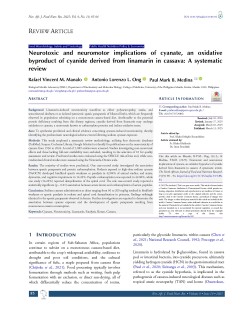Main Article Content
Neurotoxic and neuromotor implications of cyanate, an oxidative byproduct of cyanide derived from linamarin in cassava: A systematic review
Abstract
Background Linamarin-induced neurotoxicity manifests as either polyneuropathy, ataxia, and sensorineural deafness or as isolated symmetric spastic paraparesis of bilateral limbs, which are frequently observed in populations subsisting on a monotonous cassava-based diet. Attributable to the potential protein deficiency resulting from this dietary regimen, cyanide derived from linamarin may undergo oxidation to cyanate, a neurotoxin known to carbamoylate proteins and induce oxidative stress.
Aim: To synthesize preclinical and clinical evidence concerning cyanate-induced neurotoxicity, thereby identifying the predominant neurological adverse events following sodium cyanate exposure.
Methods: This study employed a systematic review methodology, utilizing four electronic databases (PubMed, Scopus, Cochrane Library, Google Scholar) to identify for publications on the neurotoxicity of cyanate from 1936 to 2024. A total of 1,089 articles were screened. Studies investigating non-neurotoxic effects and those lacking full-text availability were excluded, resulting in the selection of 10 for quality assessment and review. Preclinical studies were evaluated using the SYRCLE risk-of-bias tool, while non-randomized clinical studies were assessed using the Newcastle-Ottawa scale.
Results: The majority of studies were preclinical. One case-control study investigated the association between spastic paraparesis and protein carbamoylation. Rodents exposed to high-dose sodium cyanate (NaOCN) developed hindlimb spastic weakness or paralysis in 42.86% of animal studies, and ataxia, dysmetria, and cognitive impairment in 14.26%. Peptide carbamoylation was reported in 42.86%, while one study (14.26%) reported demyelination of the spinal cord. The sole case-control study reported a statistically significant (p = 0.01) association between severe konzo and carbamoylation of serum peptides.
Conclusion: Sodium cyanate administration at doses ranging from 60 to 200 mg/kg resulted in hindlimb weakness or spastic paralysis in rodents and spinal cord demyelination in primates, findings strikingly identical to the spastic paraparesis observed in konzo. Further investigations are required to determine the association between cyanate exposure and the development of spastic paraparesis resulting from monotonous cassava consumption.
Keywords: Cyanate, Neurotoxicity, Linamarin, Paralysis, Konzo, Cassava.







